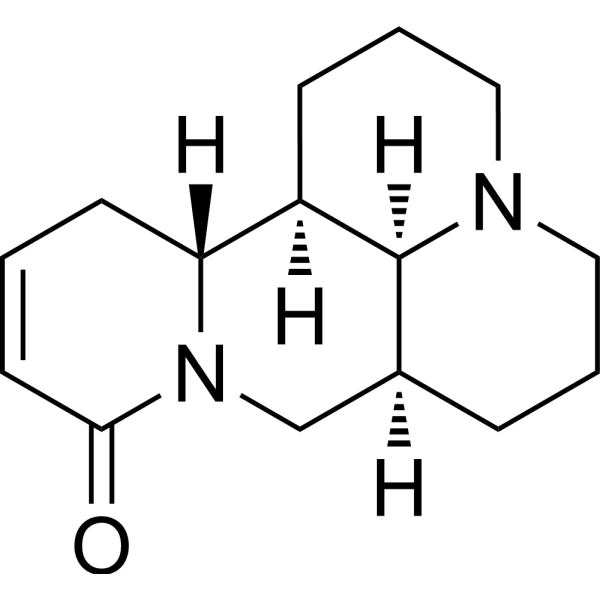
Sophocarpine
CAS No. 6483-15-4
Sophocarpine( —— )
Catalog No. M28556 CAS No. 6483-15-4
Sophocarpine has anti-cancer, anti-inflammatory, anti-nociceptive, and antivirus activities, it can prevent implant loosening through inhibiting osteoclast formation and bone resorption.
Purity : >98% (HPLC)
 COA
COA
 Datasheet
Datasheet
 HNMR
HNMR
 HPLC
HPLC
 MSDS
MSDS
 Handing Instructions
Handing Instructions
| Size | Price / USD | Stock | Quantity |
| 5MG | 41 | Get Quote |


|
| 10MG | 65 | Get Quote |


|
| 25MG | 131 | Get Quote |


|
| 50MG | 194 | Get Quote |


|
| 100MG | 290 | Get Quote |


|
| 200MG | Get Quote | Get Quote |


|
| 500MG | Get Quote | Get Quote |


|
| 1G | Get Quote | Get Quote |


|
Biological Information
-
Product NameSophocarpine
-
NoteResearch use only, not for human use.
-
Brief DescriptionSophocarpine has anti-cancer, anti-inflammatory, anti-nociceptive, and antivirus activities, it can prevent implant loosening through inhibiting osteoclast formation and bone resorption.
-
DescriptionSophocarpine has anti-cancer, anti-inflammatory, anti-nociceptive, and antivirus activities, it can prevent implant loosening through inhibiting osteoclast formation and bone resorption, thus, it may be a novel therapeutic agent to prevent prosthesis loosening and for osteolytic diseases. Sophocarpine could attenuate ConA-induced liver injury, and the protective effect of Sophocarpine was associated with its inhibition effect of pro-inflammatory cytokines, chemokines, and the IFN-γ/STAT1 signaling pathway.(In Vitro):To investigate the antiviral effect of thymopolypeptides combined with 4 kinds of matrine type alkaloids on HepG2.2.15 cells, oxymatrine, sophocarpidine, Sophocarpine, and sophoridine (at concentration of 0.2 mmol/L; respectively) were respectively combined with thymopolypeptides (0.025, 0.1 g/L), and after 48 h and 72 h treatment on HepG2.2.15 cells, the cells and supernatants were collected. The cells activity in various groups was determined by CCK-8 method to evaluate the toxic effects of the drugs on HepG2.2.15 cells. Enzyme linked immunosorbent assay (ELISA) was used to determine HBeAg and HBsAg levels in cellular supernatants. HBV DNA levels in cellular supernatants andcells were quantified with fluorogenic quantitative PCR method; and the expression level of IFN-α in supernatants was detected with CBA method. The results indicated that single thymopolypeptides at 0.025-0.4 g/L; had no toxicity to cells. Thymopolypeptides in this concentration range combined with 0.2 mmol/L; matrine type alkaloids also had no toxicity to cells. Anti-HBV activity of drug combination was better than that of alkali or thymopolypeptides alone. Thymopolypeptides at 0.025 g/L; had better inhibitory effect than thymopolypeptides at 0.1 g/L; on intracellular HBV DNA expression, but the inhibitory effect on supernatant HBeAg level was on the contrary. Anti-HBV activity was similar between alkaloids combined with 0.1 g/L; and alkaloids combined with 0.025 g/L;. There was no statistical difference in anti-HBV effect between various combined groups (P<0.05). In general, 72 h anti-HBV effect was better than 48 h anti-HBV effect (P<0.05). The expression of IFN-α was increased after drug combination, with positive correlation to the changes of other four indicators (P<0.05).(In Vivo):Inoculation (s.c.) of colon26 adenocarcinoma cells into BALB/c mice induced cachexia, as evidenced by progressive weight loss, reduction in food intake, wasting of gastrocnemius muscle and epididymal fat, and increase in serum levels of TNF-alpha and IL-6. Administration of 50 mg/kg/d sophocarpine or matrine for 5 days from the onset of cachexia did not inhibit the tumor growth but resulted in attenuation of cachexia symptoms. Furthermore, sophocarpine and matrine decreased the serum levels of TNF-alpha and IL-6, and sophocarpine showed a better therapeutic effect than matrine.
-
In Vitro——
-
In Vivo——
-
Synonyms——
-
PathwayApoptosis
-
TargetPERK
-
Recptor——
-
Research Area——
-
Indication——
Chemical Information
-
CAS Number6483-15-4
-
Formula Weight246.35
-
Molecular FormulaC15H22N2O
-
Purity>98% (HPLC)
-
SolubilityIn Vitro:?DMSO : 50 mg/mL (202.96 mM)
-
SMILESO=C(C=CC1)N(C[C@@H]2CCC3)[C@H]1[C@@H]1[C@H]2N3CCC1
-
Chemical Name——
Shipping & Storage Information
-
Storage(-20℃)
-
ShippingWith Ice Pack
-
Stability≥ 2 years
Reference
1.Prichard BN, et al. Xipamide. A review of its pharmacodynamic and pharmacokinetic properties and therapeutic efficacy. Drugs. 1985 Oct;30(4):313-32.
molnova catalog



related products
-
Beta-Tocopherol
Beta-Tocopherol shows effect on human erythroleukemia cell (HEL) adhesion induced by phorbol 12-myristate 13-acetate (PMA).
-
Fustin
Fustin is the phytogenic flavanol component of the plant Rhus verniciflua Stokes. Fustin shows protective effects on 6-hydroxydopamine-induced neuronal cell death.
-
CCT020312
CCT020312 (0-9 μM, 24 h) treatment of medium HT29 cells for 24 h resulted in a concentration-dependent loss of P-S608-pRB signaling with linear response values between 1.8 and 6.1 μM.



 Cart
Cart
 sales@molnova.com
sales@molnova.com


